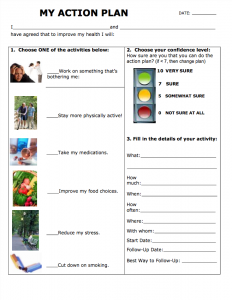By Cindy Brach, MPP, Senior Health Care Researcher, Agency for Healthcare Research and Quality
Ever have a patient who knows he needs to lose weight, but the amount of weight is so daunting that he doesn’t know how to get started? Or a patient with high cholesterol who is having trouble making lifestyle changes that would reduce her risk of a cardiovascular event? If so, you might want to start making action plans with your patients.
What Are Action Plans?
Action plans, created jointly by clinicians and patients, spell out small and realistic steps the patient is planning to take to address a health goal. In addition to making changes to diets and physical activity routines, action plans can be used for a wide variety of goals—including stopping smoking, reducing stress, and improving sleep habits. Research has shown that a majority of patients who made an action plan in a primary care site reported making an associated behavior change.
How to Begin Action Planning
You might want to start by conducting a health assessment of your patients. A health assessment is a systematic collection and analysis of health-related information on a patient. It can help identify and support beneficial health behaviors and work to direct changes in potentially harmful health behaviors. Health Assessments in Primary Care, a guide from the Agency for Healthcare Research and Quality (AHRQ), can help you initiate health assessments into your practice.
Next, you’ll need to decide who is going to engage patients in action planning. It could be the primary care clinician, or it could be clinical support staff. Alternatively, you may decide to have clinicians introduce the action planning process and have clinical support staff conduct follow-up. To learn more about optimizing team functioning and handoffs, see TeamSTEPPS for Office-Based Care.
Let Patients Call the Shots
It’s critical that patients choose both the goal and the action steps they plan to take. It can be tempting to make suggestions, but action plans need to come from patients. For example, you may think the top priority change is getting more physical activity, but if the patient is more interested in modifying her diet, that’s going to be the goal. People, however, can be overly ambitious. Part of your job, therefore, is to help in the selection of realistic goals and action steps. Try having a menu of options (e.g., lists of exercises, foods to cut down on) that can give patients ideas for specific steps they can take. healthfinder.gov has lots of suggestions for making healthy changes.
Action Planning Takes Practice
Although it’s a straightforward process once you have it under your belt, action planning has many moving parts. You need to:
- Determine whether your patient is ready to make a change.
- Guide the choice of goal and action steps without taking over.
- Assess your patient’s confidence in completing the action steps and help your patient revise the plan if his confidence is not high enough.
- Identify and address barriers that could keep your patient from completing the action plan.
- Follow up after the visit and modify the plan as needed.
There are some resources that can help you use action planning to support behavior change. Look at Make Action Plans, a tool from the AHRQ Health Literacy Universal Precautions Toolkit – for details on implementing the process. Try watching videos of action planning, such as this Action Plans video from the University of California San Francisco’s Center for Excellence in Primary Care. Then try action planning with 1 or 2 patients. It may take you a little while before you master the art of letting the patient take the lead and health literacy techniques such as confirming understanding using the teach-back method. But once you’re proficient, you’ll be able to co-create an action plan in a matter of minutes.
By transforming behavior change discussions with your patients, action planning presents an opportunity to achieve concrete progress on health promotion goals.




